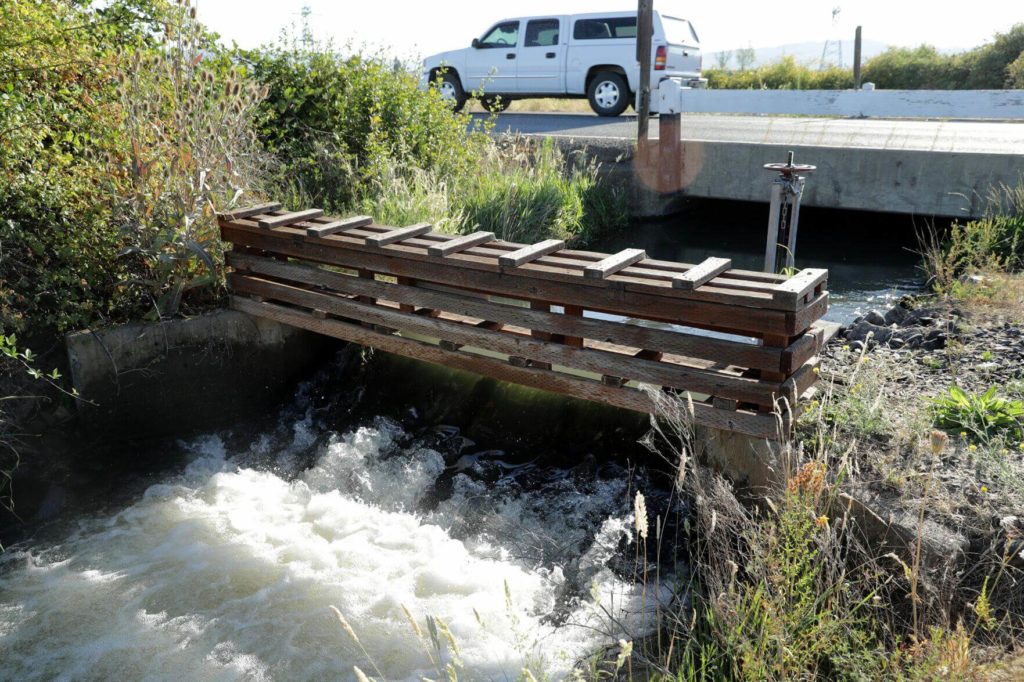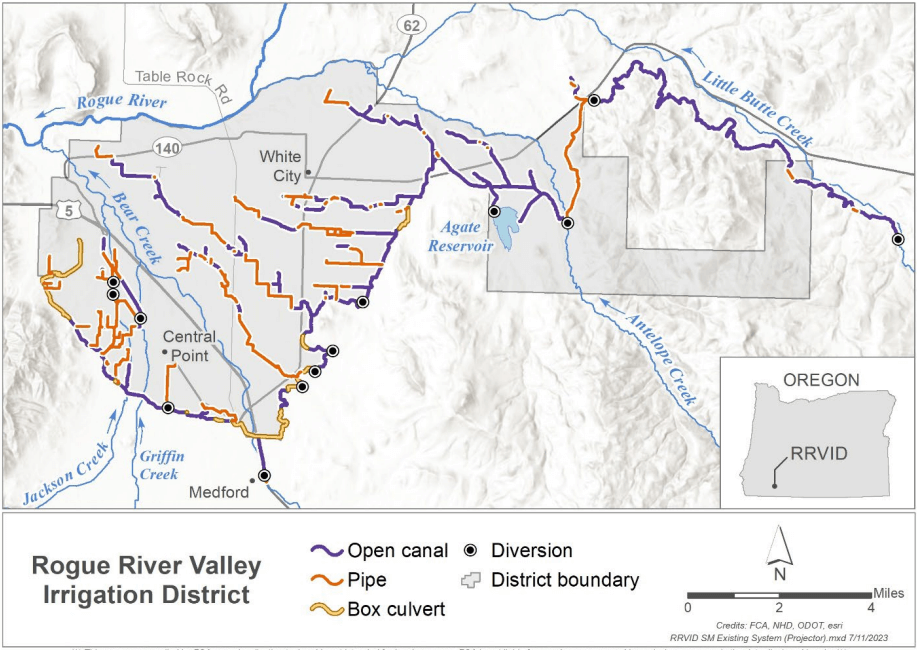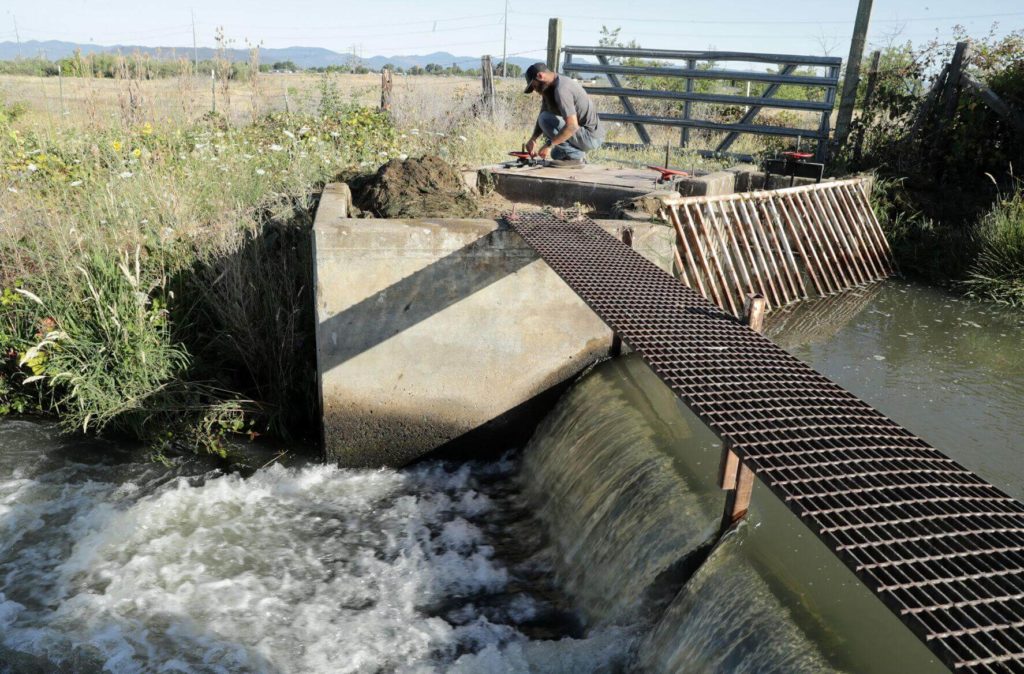By Shaun Hall | Aug. 14, 2023 | Rogue Valley Times
A big push is underway in Jackson County and Oregon to replace open-ditch irrigation canals with piping to reduce water loss through seepage and evaporation.
The mission by irrigation districts to modernize aging systems comes at a time of increased state and federal funding that is expected to help make the projects a reality.
The touted benefits of piping and related upgrades includes increased reliability of water through conservation, particularly in times of drought.
Not everybody loves the idea of doing away with canals, however. There’s been some opposition in the past in Bend and Ashland from people who prefer open ditches for their aesthetics and value to wildlife.
Three big irrigation districts in the county — the Rogue River Valley Irrigation District, Medford Irrigation District and Talent Irrigation District — are pursuing improvements, with some related public comment periods underway.
This diagram shows canals and other irrigation lines of the Rogue River Valley Irrigation District, which might replace its open irrigation canals with piping to reduce water loss from seepage and evaporation. Recent state and federal funding increases might help pay for the project and similar projects in other districts.
Brian Hampson, general manager of RRVID and president of the industry association Oregon Water Resources Congress, is supportive of piping projects. The district has 53 miles of open canals and laterals, plus about 40 miles of lines that are already piped or in culverts.
“It’s 70 years old since the last modernization, so it’s time to do something,” Hampson said in a phone interview last week. “Our infrastructure is getting old and deteriorating.”
“In the 2000s, we’re starting to fight drought and heat,” he said. “Piping, of course, is the No. 1 thing we’re looking at. We’re also looking at lining.” Canals traditionally have been lined with cement.
Piping can help conserve water, keep water in reservoirs and keep some of it in-stream to serve fish, according to Hampson.
A district watershed plan with related environmental assessments is in the making. Options include piping the main Hopkins Canal and possibly miles of lateral lines.
A related effort also is underway with the Medford Irrigation District to pipe the 13-mile Joint System Canal serving both districts. The canal brings water down from the Cascade Mountains northeast of Medford.
“We’re losing a lot of water bringing it down the mountain,” Hampson said.
Drought and increased heat in the past decade has made modernization more urgent, he said.
“Climate change is in the forefront for everybody to read and try to understand,” he said. “The way it’s been the last 10 years, it’s been trending that way. This winter we had a pretty good winter.”
Funding for modernization projects got a $50 million boost from the Oregon Legislature in its just-completed session, money that can be used as a required match for funding under the federal Infrastructure Investment and Jobs Act, signed by President Joe Biden in November 2021. Match requirements for federal grants for modernization range from 20 percent to 50 percent.
The Oregon Water Resources Congress, the industry organization headed up by Hampson, had asked the Legislature for $70 million, under Senate Bill 5030. April Snell, the organization’s executive director, submitted testimony to the Joint Ways and Means Subcommittee on Capital Construction in support of the funding.
“Providing state match to districts will unlock a historic amount of federal funding for multi-benefit projects that will help Oregon be more resilient to drought and water scarcity,” she wrote to the subcommittee in May. “Our members, and the thousands of water users they serve, are a vital component of Oregon’s economic engine, delivering water supplies used to grow 240-plus different commodities sold and consumed locally, nationally and globally.”
Besides enhanced resilience to drought and increased water supply, Snell said the benefits from modernization — primarily through piping — includes improved water quality, increased in-stream flows for fish and aquatic habitat, and increased public safety.
Water quality can improve because ditches would no longer be open and susceptible to contamination. Costs for operations and maintenance are expected to be lower, too.
And risks to public safety such as drownings can be reduced with the elimination of open water-filled ditches. Drownings in canals have occurred in Central Oregon. Last year in Medford, a man was found dead in a canal.
Snell highlighted several water district modernization projects around the state, including a project by the Talent Irrigation District to pipe its 23.2-mile Eastside Canal and 1.2-mile Billings Siphon, which serves 10,400 irrigated acres.
“The Eastside Canal loses up to 28 percent of its water to seepage and evaporation, exacerbating the impact of drought, an ongoing challenge in the basin,” Snell said. “TID has had insufficient water in the last decade to make deliveries for the full irrigation season, impacting agricultural production and contributing to lower streamflows, affecting fish and aquatic habitat.”
The project would enhance streamflow and water quality in Emigrant Creek, she said.
Wanda Derry, manager of the Talent district, said she expects to apply for state and federal funding, in order to pipe the Eastside Canal, which runs north from Emigrant Lake, along the east side of the valley.
“It really eliminates the seepage and evaporation,” Derry said, referring to piping.
The district has 122 miles of canals, including collection and delivery canals. The system is connected with Hyatt and Howard Prairie reservoirs in the Cascade Mountains east of Ashland.
Derry said she’s heard of no opposition to the district’s piping plans, although opposition arose elsewhere in the past to projects in Bend and Ashland.
“They really like their water feature,” she said.
The district provides irrigation water under contract with the city of Ashland, which has a canal traversing its west side. Four years ago, significant opposition to a city plan to pipe the canal surfaced, with the City Council and mayor voting against the plan.
In Bend, similar opposition arose last year when a group named Save Arnold Canal filed a lawsuit to oppose the Arnold Irrigation District’s plans to pipe 12 miles of canal. In May, Patti Adair, a Deschutes County commissioner, opposed the $43 million plan, saying the cost of the project was not worth the water savings and that the pipe will negatively impact properties near the canal. Adair wrote to U.S. Rep. Cliff Bentz (R—Ontario), but he replied that he supported the piping, according to The Bulletin newspaper.
This story originally appeared in the Rogue Valley Times on Aug. 14, 2023. Photos by Andy Atkinson, diagram courtesy of the Rogue Valley Irrigation District.



